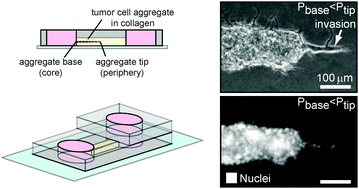Interstitial fluid pressure regulates collective invasion in engineered human breast tumors via Snail, vimentin, and E-cadherin†
Abstract
Many solid tumors exhibit elevated interstitial fluid pressure (IFP). This elevated pressure within the core of the tumor results in outward flow of interstitial fluid to the tumor periphery. We previously found that the directionality of IFP gradients modulates collective invasion from the surface of patterned three-dimensional (3D) aggregates of MDA-MB-231 human breast cancer cells. Here, we used this 3D engineered tumor model to investigate the molecular mechanisms underlying IFP-induced changes in invasive phenotype. We found that IFP alters the expression of genes associated with epithelial–mesenchymal transition (EMT). Specifically, the levels of Snail, vimentin, and E-cadherin were increased under pressure conditions that promoted collective invasion. These changes in gene expression were sufficient to direct collective invasion in response to IFP. Furthermore, we found that IFP modulates the motility and persistence of individual cells within the aggregates, which are also influenced by the expression levels of EMT markers. Together, these data provide insight into the molecular mechanisms that guide collective invasion from primary tumors in response to IFP.


 Please wait while we load your content...
Please wait while we load your content...